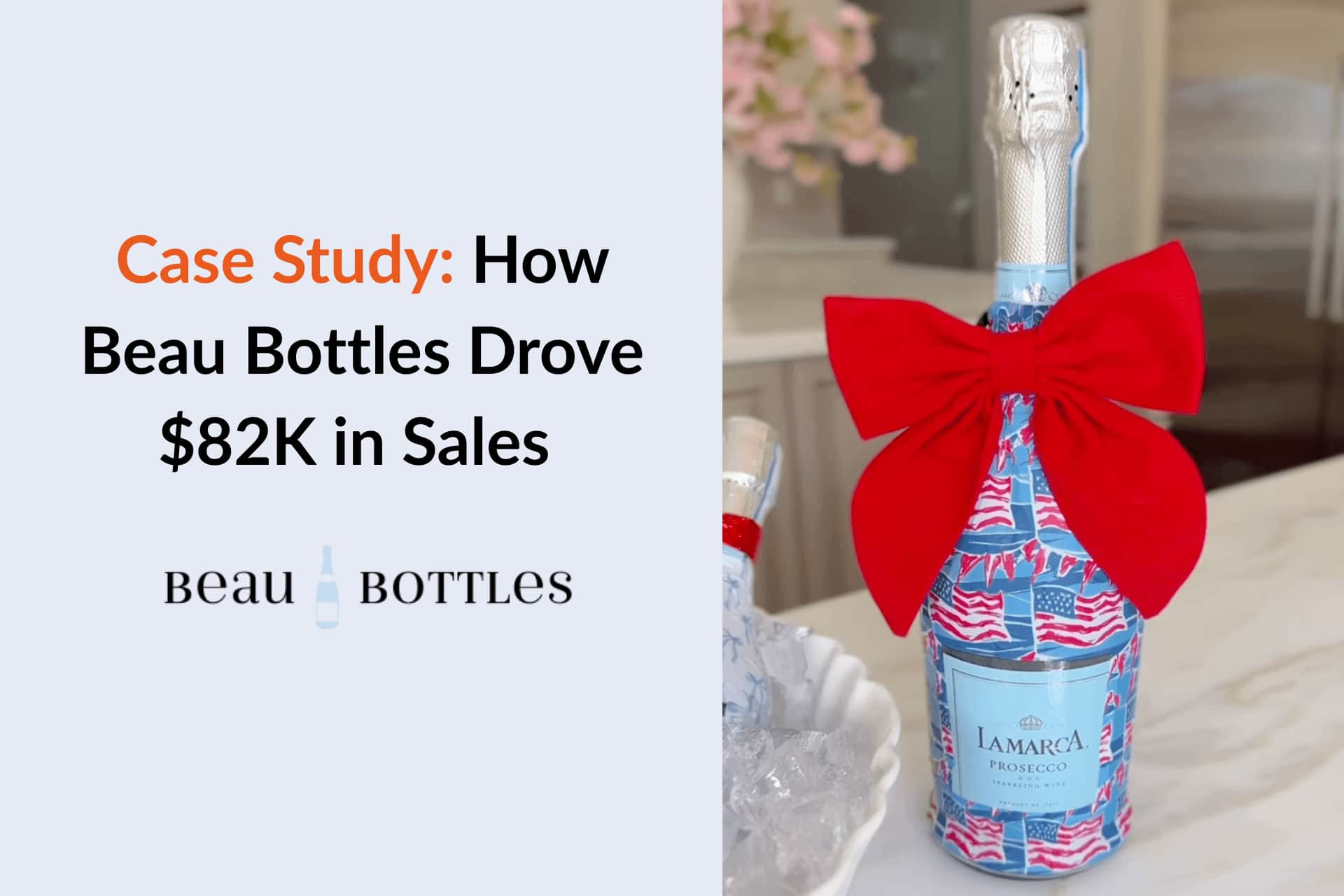





Famstar is a popular influencer marketing platform, but many users are seeking alternatives due to a few limitations. While Famstar is known for its influencer discovery and campaign management, users have raised concerns about its lack of advanced reporting and analytics tools, the limited customization of its interface, and difficulty integrating with eCommerce platforms.
Additionally, the platform’s pricing is often seen as high for smaller businesses or brands just starting with influencer marketing. These drawbacks have led users to explore other options that offer more comprehensive features and flexibility, particularly when it comes to performance tracking and cost-effectiveness.
In this article, we will explore the top 10 Famstar alternatives, providing a detailed comparison of their features, pricing, and customer reviews to help you find the right platform for your brand’s influencer marketing needs. Here are the alternatives we’ll cover:
While Famstar offers a range of features for influencer marketing, several users have expressed concerns that have led them to seek alternatives. Through extensive research on platforms like Reddit, G2, and other forums, four key pain points have emerged:
Users have noted that Famstar's analytics tools are basic and lack depth, making it challenging to assess campaign performance effectively. This limitation hinders data-driven decision-making and ROI measurement.
Many brands, especially small to medium-sized businesses, find Famstar's pricing to be on the higher side. This cost can be prohibitive for companies with limited marketing budgets, prompting them to explore more affordable alternatives.
The platform's automation capabilities are considered basic, requiring manual intervention for tasks that could be streamlined. This inefficiency increases the time and effort needed to manage campaigns.
Famstar's integration with e-commerce platforms is minimal, restricting brands from seamlessly linking influencer campaigns with their online stores. This gap can affect the ability to track sales conversions directly resulting from influencer partnerships.
Our comparison focuses on several key aspects:
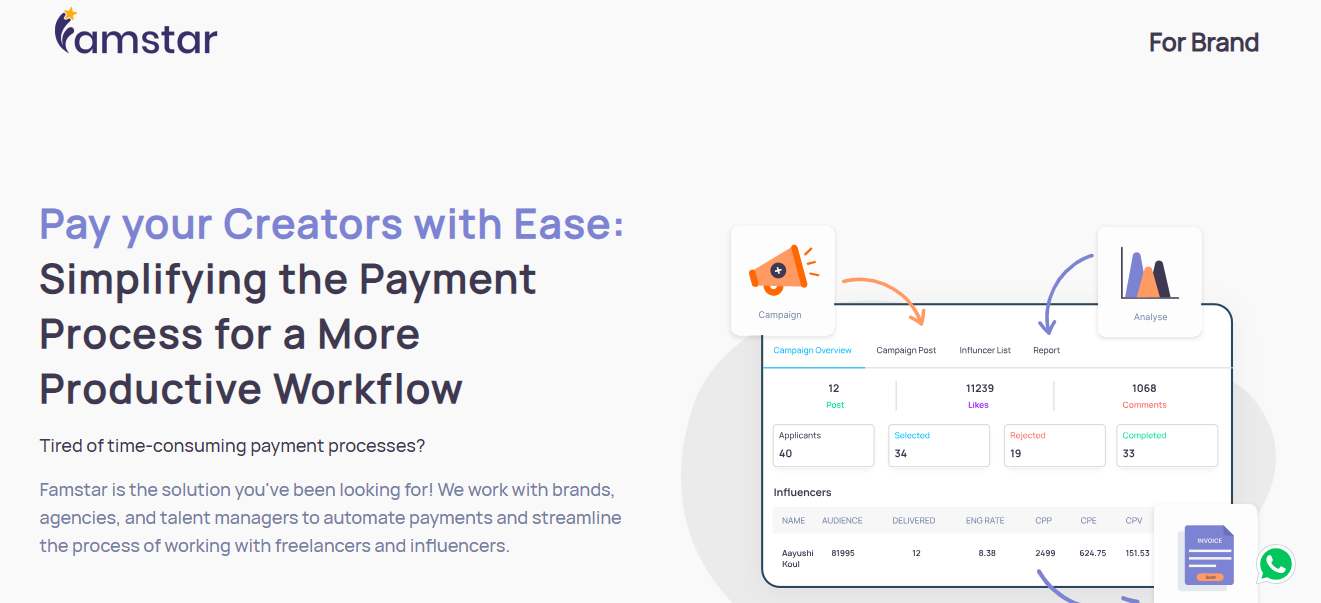
Best For: Famstar is best for brands looking to scale their influencer marketing campaigns in India, particularly those focused on leveraging local creators and content for regional outreach.
Platform Coverage:
Pricing: Based on our research, Famstar does not publicly list detailed pricing. Brands need to contact Famstar directly for a quote. There’s a free trial option for brands to explore the platform before committing.
Reviews: 4.7 / 5.0 (G2)
Ease of Use (UX/UI): Famstar is known for its straightforward interface that is easy to navigate for both brands and influencers. Users have highlighted that the platform’s workflows for campaign creation, content approval, and influencer payment are intuitive and simple, which contributes to a seamless user experience. However, some users have noted that the limited number of features, such as advanced analytics or cross-platform support, may affect the experience for larger-scale campaigns.
Customer Support: Famstar’s customer support is generally praised for being responsive and effective. The platform’s vetting process for influencers adds an extra layer of trust, and users appreciate the transparency in communication. However, the process for content approval and influencer verification can sometimes slow down operations, which some users have pointed out as an area for improvement.

Best For: Influencer Hero is best for growing D2C brands and eCommerce teams looking to scale their influencer marketing campaigns across multiple platforms with deep insights, automation tools, and a strong focus on ROI.
Platform Coverage:
Pricing: Influencer Hero offers flexible pricing plans to accommodate growing brands. All plans include core features and can scale as the influencer program grows.
Reviews: 5.0 / 5.0 (Capterra)
Ease of Use (UX/UI): Influencer Hero is known for its intuitive design and user-friendly interface, offering a streamlined dashboard, automated workflows, and customizable email templates. The platform is built to save time with drag-and-drop campaign setup and automation features, making it easy for both beginners and seasoned marketers to manage influencer campaigns without a steep learning curve.
Customer Support: Influencer Hero’s customer support is widely praised as one of its strongest features. The platform provides 24/7 real-human live chat, responsive email support, and an extensive Help Center filled with written and video tutorials. Every plan includes a dedicated account manager from day one, with optional strategy consultations to help guide your growth. Pro plan users also enjoy access to a private Slack channel for quicker, continuous support.
Famstar is primarily focused on the Indian market, catering to brands looking to target Indian influencers and creators. It has a more localized approach and offers a fast 24-hour payment system for influencers. However, Famstar lacks the extensive cross-platform support and advanced features that Influencer Hero offers.
Influencer Hero, on the other hand, supports influencer marketing across eight major social platforms, including Instagram, TikTok, YouTube, and Facebook. It is highly versatile and ideal for growing D2C brands and eCommerce teams.
Influencer Hero's pricing starts at $649/month and scales based on the number of creators, making it suitable for larger campaigns. Additionally, it stands out with AI-powered CRM, advanced eCommerce integrations, and superior customer support, including dedicated account managers for every plan. This positions Influencer Hero as a more scalable and feature-rich platform for global campaigns compared to Famstar.
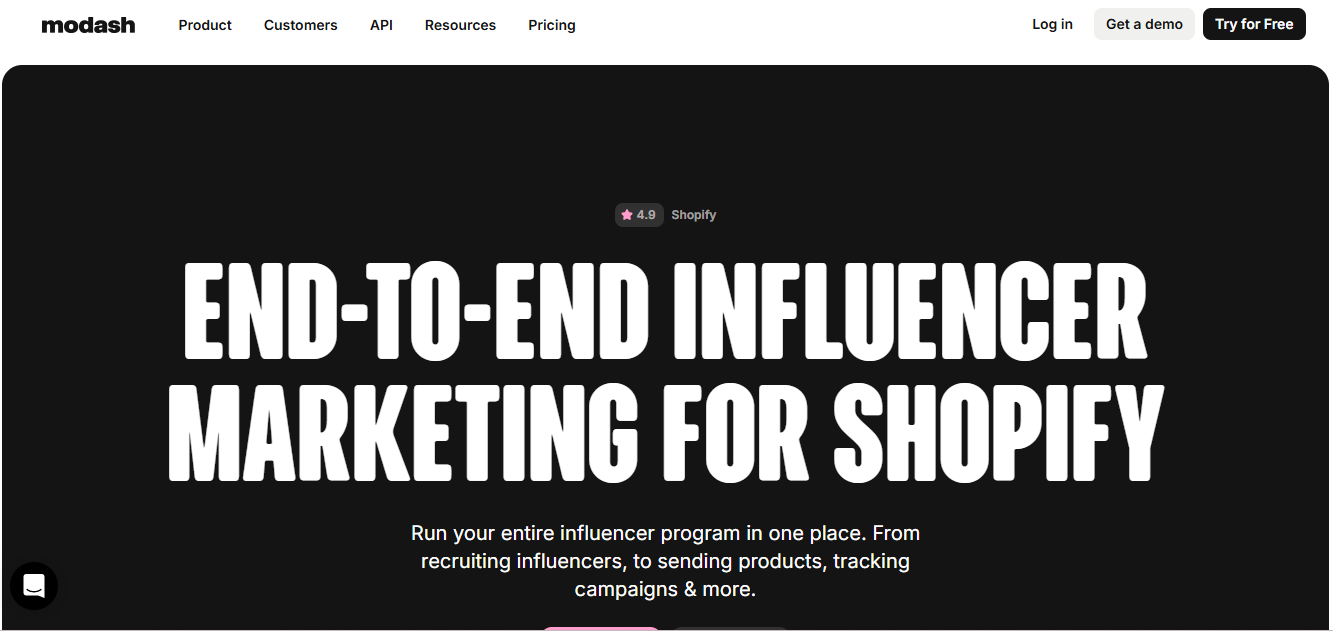
Best For: Modash is best for eCommerce brands looking to scale their influencer marketing campaigns with a focus on discovery, affiliate tracking, and automated outreach, especially those using Shopify.
Platform Coverage:
Pricing: There are different plans and options.
Reviews: 4.7/5 (G2)
Ease of Use (UX/UI): Modash is highly regarded for its user-friendly interface and intuitive design, allowing brands to easily navigate through influencer discovery, outreach, and campaign management. Users appreciate the streamlined workflows that enable them to go from discovery to campaign execution and influencer payment seamlessly. The platform offers powerful filters and AI-based search tools that simplify the influencer selection process.
Customer Support: Modash offers strong customer support with a dedicated account manager and personalized onboarding sessions. Users report quick response times via email and WhatsApp, with a focus on making sure campaigns run smoothly. However, some have noted that the platform’s lack of native content licensing and UGC management tools could require more hands-on involvement from users.
Famstar is an influencer marketing platform primarily focused on connecting brands with creators in India. It offers tools for influencer discovery, campaign management, and performance analytics. Famstar allows brands to set up campaigns, approve content, and pay influencers within 24 hours of content approval. It's designed for small to medium-sized businesses targeting the Indian market, with a focus on nano to macro influencers and fast payment processes.
On the other hand, Modash is a global influencer marketing platform designed to serve brands looking for influencer discovery and campaign management at scale. It provides a comprehensive database of over 250 million creators, advanced filtering options, and AI-powered discovery tools. Modash also offers features such as AI-driven outreach, customizable reporting, and real-time analytics, making it a strong choice for brands with global campaigns. Pricing for Modash starts at $199/month, making it more accessible for brands of various sizes.
Famstar is a great option for brands looking to engage with Indian influencers and manage localized campaigns, while Modash is better suited for global brands that require more advanced tracking, AI-powered tools, and a broader influencer database.

Best For: Upfluence is best for eCommerce brands, particularly those on Shopify or Amazon, looking to scale their influencer marketing campaigns with advanced tools for influencer discovery, campaign management, and ROI tracking.
Platform Coverage:
Pricing:
Reviews: 4.5/5 (G2)
Ease of Use (UX/UI): Upfluence is highly praised for its intuitive design and easy-to-navigate interface. Users note that the platform’s all-in-one setup allows brands to seamlessly manage influencer discovery, outreach, and payments in one place. The filtering and search options are robust, allowing for detailed segmentation of influencers, but some users find the learning curve a bit steep when first starting.
Customer Support: Upfluence offers excellent customer support with dedicated account managers, responsive email support, and personalized onboarding sessions. Users appreciate the helpfulness and quick responses of the support team. However, some users report that the platform’s complexity can lead to an initial challenge in getting the most out of the system without detailed assistance.
Famstar connects brands with Indian influencers, offering influencer discovery, campaign management, and fast influencer payouts. It supports influencer vetting to ensure safety and credibility, with content ownership rules clearly defined. Brands targeting the Indian market will benefit from Famstar’s understanding of regional niches and its quick payout system.
Upfluence, in contrast, serves a global market and is an all-in-one influencer marketing platform with advanced analytics, customizable reporting, and a strong emphasis on eCommerce integrations (such as Shopify and Amazon). Upfluence supports multi-platform searches and provides features like affiliate tracking, product gifting management, and performance analysis.
Choose Famstar if you're a brand looking for a cost-effective solution with a focus on Indian influencers. Choose Upfluence if you need a more comprehensive, global platform with eCommerce integration and robust analytics for enterprise-scale campaigns.

Best For: Captiv8 is best suited for large enterprises and brands looking to scale influencer marketing campaigns across various platforms. It offers advanced campaign tracking, influencer discovery, and data analytics, making it ideal for brands focusing on performance-driven influencer partnerships.
Platform Coverage:
Pricing: There are different pricing options:
Reviews: 4.1/5 (G2)
Ease of Use (UX/UI): Users report that Captiv8's platform is intuitive, especially for those familiar with influencer marketing. The filtering options for creator discovery are highly detailed, making it easy to find the right influencers based on specific criteria like demographics, location, and interests. However, the platform is considered complex by some users, particularly in managing multiple campaigns simultaneously and requires an initial learning curve.
Customer Support: Captiv8's customer support has received mixed reviews. While there is a dedicated account manager for each client, some users have mentioned delayed responses and difficulties in resolving issues, particularly with payment processing. Overall, the support is personalized but could be more responsive according to feedback.
Famstar provides a localized influencer marketing solution, particularly for Indian brands. With a focus on quick influencer payments, influencer vetting, and a simpler user interface, it allows brands to run campaigns with ease. Famstar is ideal for brands targeting the Indian market and offers a fast, efficient approach to influencer marketing.
Captiv8 is an enterprise-focused platform that provides influencer discovery, campaign management, and advanced analytics. Captiv8’s pricing starts at $25,000 annually, making it best suited for larger organizations. It offers advanced reporting tools, global reach, and storefront integrations for influencer marketing campaigns. However, its pricing and focus on enterprise clients may limit its accessibility for smaller businesses.
If you're targeting the Indian market and need a simplified influencer management solution, Famstar is the better choice. However, if you're an enterprise-level brand looking for advanced analytics, global reach, and competitive insights, Captiv8 would be the more suitable platform.

Best For: CreatorIQ is best for global brands looking to scale their influencer marketing efforts across various platforms like Instagram, TikTok, YouTube, and more. It is particularly suited for those who want to manage the entire influencer lifecycle—from discovery and outreach to campaign management and reporting.
Platform Coverage:
Pricing: There are different plans:
Reviews: 4.7/5 (G2)
Ease of Use (UX/UI): Users generally praise CreatorIQ for its clean and intuitive interface, which simplifies influencer discovery and campaign management. The platform's advanced filtering capabilities make it easy to find influencers that match specific criteria. However, the robust features might require a learning curve for beginners.
Customer Support: CreatorIQ is known for its outstanding customer support, with a dedicated implementation manager and customer success team. Users appreciate the hands-on approach, with strategic guidance provided for onboarding and campaign management. This personalized support is highly valued for large-scale influencer campaigns.
Famstar is focused on the Indian market, making it an excellent choice for brands targeting Indian creators or regional campaigns. It stands out with its quick influencer payment system (24 hours after content approval) and its emphasis on working with nano and micro-influencers. The platform is designed for brands with simpler needs and offers fast onboarding, straightforward workflows, and affordable pricing for smaller teams.
In contrast, CreatorIQ is a global influencer marketing platform used by large brands like Disney and Coca-Cola, offering AI-powered influencer discovery and robust tools for campaign management and performance tracking However, CreatorIQ comes with a higher cost, and the platform may not be the best fit for smaller brands or those looking for a more localized, budget-friendly solution.
For brands targeting the Indian market, Famstar offers affordable and quick solutions, focusing on local influencer pools and efficient payment systems. However, for global brands that need comprehensive AI tools, advanced reporting, and platform integrations, CreatorIQ is the better choice despite its higher price point.

Best For: HypeAuditor is best suited for brands and agencies looking to discover and analyze influencers across platforms like Instagram, TikTok, YouTube, and more. It excels in AI-powered influencer discovery and campaign tracking, helping brands improve their influencer marketing campaigns through comprehensive data insights.
Platform Coverage:
Pricing: HypeAuditor’s pricing is customizable, with the standard “Business” plan starting at around $10,000/year. Pricing can be adjusted based on the number of reports, active campaigns, and platform usage. They also offer a 24–48 hour free trial for new users.
Reviews: 4.6/5 (G2)
Ease of Use (UX/UI): HypeAuditor’s interface is generally praised for being user-friendly and intuitive, making it easy for brands to search for influencers and track campaign progress. The platform offers advanced features like AI-powered filtering and social listening, but users note that beginners may need some onboarding to fully utilize all of the platform's tools.
Customer Support: HypeAuditor offers strong customer support, with personalized onboarding and a responsive team. Users appreciate the detailed help guides and the ability to contact support directly when needed. However, the complexity of the platform may require a learning curve for new users.
Famstar is an AI-powered platform based in India, designed to streamline influencer marketing campaigns for brands targeting the Indian market. HypeAuditor, on the other hand, is a global platform that provides comprehensive analytics and campaign management tools.
Choose Famstar if you're a brand looking to execute influencer marketing campaigns specifically in India, especially if you're interested in platforms like Snapchat. It's ideal for those seeking quick influencer onboarding and payments.
Opt for HypeAuditor if you're aiming for a global influencer marketing strategy with in-depth analytics and the ability to manage campaigns across multiple social media platforms. It's suitable for brands that require comprehensive data insights and a broader influencer reach.

Best For: GRIN is ideal for eCommerce and DTC brands looking to manage their influencer marketing from discovery to content creation, gifting, payments, and performance analysis all in one unified platform. It is especially beneficial for brands using Shopify or similar platforms for streamlined product seeding, affiliate tracking, and UGC collection.
Platform Coverage:
Pricing:
Reviews: 4.5 / 5.0 (G2)
Ease of Use (UX/UI): Users generally find GRIN to be intuitive with a user-friendly interface for managing influencer campaigns from start to finish. Its integrated features like email syncing, content management, and payment processing are praised for simplifying the workflow. However, some users mention the platform can be complex for beginners, requiring some initial onboarding or training to use all features effectively.
Customer Support: GRIN offers strong customer support, with options for dedicated program strategists and ongoing assistance for campaign execution. However, some users have reported delays or unresolved issues with customer support, and inconsistent follow-through on tickets or support inquiries. Despite this, many users appreciate the personalized support provided by account managers.
GRIN is a powerful influencer marketing platform tailored to eCommerce and DTC brands, offering AI-powered influencer discovery, seamless Shopify integration, and end-to-end campaign management. It's well-suited for brands looking to manage the entire influencer journey from discovery and gifting to payment processing and performance tracking. However, it comes with a high starting price of $2,500/month and requires an annual commitment, which may be restrictive for smaller brands.
Famstar, on the other hand, is more budget-friendly and focused on the Indian market. It offers a simple user interface, quick influencer payment (within 24 hours), and fast onboarding but lacks the advanced AI discovery and eCommerce integrations that GRIN offers.
If you're looking for a local Indian solution with faster payments, Famstar could be a better fit. However, if you're managing large-scale global campaigns and need comprehensive eCommerce integration, GRIN would be the more suitable choice.
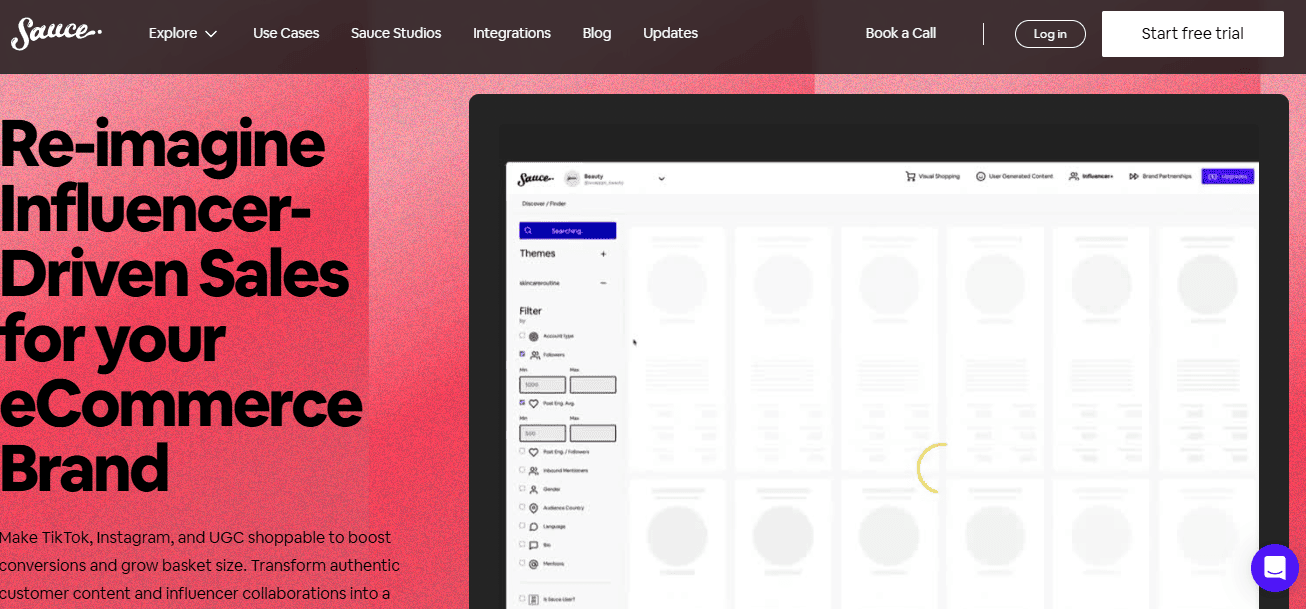
Best For: Sauce is best for eCommerce brands looking to integrate social commerce with influencer-driven content to drive conversions and grow average order value (AOV) by creating engaging shoppable galleries and video commerce experiences.
Platform Coverage:
Pricing: Based on our research, Sauce offers different plans. All plans include a 7-day free trial with the option to switch or cancel anytime.
Reviews: 4.6 / 5.0 (G2)
Ease of Use (UX/UI): Sauce has been praised for its zero-code setup, making it easy for brands to quickly implement shoppable galleries and video content. Reviews highlight its clean, intuitive design that is well-suited for users without technical expertise. The platform allows seamless integration with Shopify and other eCommerce platforms, ensuring a smooth user experience.
Customer Support: Sauce is known for its responsive support, which includes live chat and email assistance. Users appreciate the platform's helpful customer service, especially when troubleshooting issues related to gallery setup and integration with eCommerce platforms like Shopify.
Famstar and Sauce are both platforms designed to streamline influencer marketing and content-driven sales, but they cater to different needs and markets. Famstar is primarily focused on influencer discovery and campaign management in India, providing a simple, cost-effective service for brands looking to work with local creators. It offers fast payments to influencers and a straightforward UX, but it is limited by its India-centric focus and lack of advanced integrations.
On the other hand, Sauce provides a more comprehensive social commerce solution, focusing on turning influencer and UGC content into shoppable experiences. Its deep integration with platforms like Instagram and TikTok, along with powerful analytics and ROI tracking, makes it ideal for eCommerce brands aiming to boost conversions across web, email, and mobile platforms. However, Sauce's pricing model is based on impressions and sales, which may increase costs as usage scales.
For brands seeking local influencer partnerships and budget-friendly solutions, Famstar is an ideal choice. For businesses aiming to integrate social commerce with influencer content at scale, Sauce is the better option.
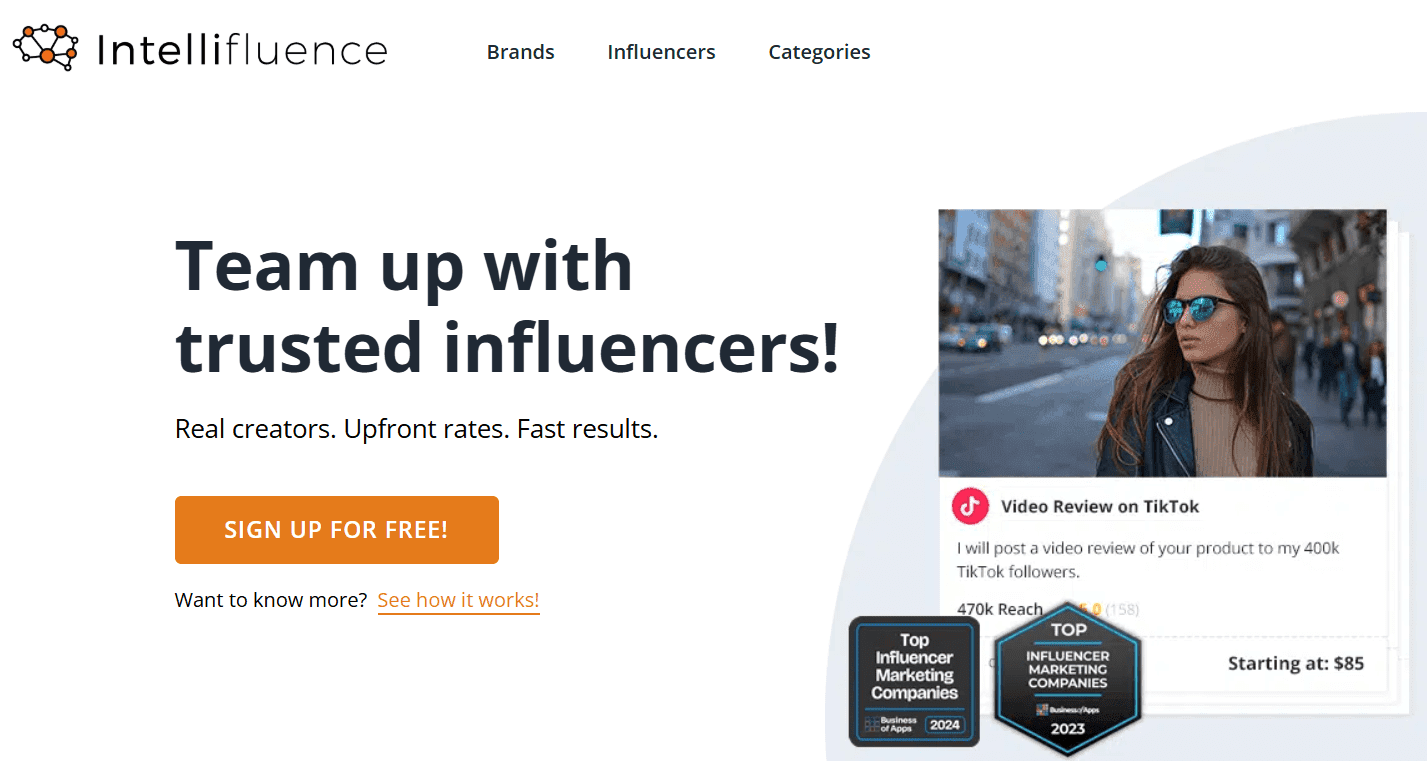
Best For: Intellifluence is best for small to medium-sized brands that want flexible, scalable influencer marketing solutions without long-term contracts. It is particularly effective for working with micro- and nano-influencers, generating UGC, and testing campaigns across multiple platforms such as Instagram, TikTok, and YouTube.
Platform Coverage:
Pricing: Based on our research, there are different options and pricings:
Reviews: 3.9/5.0 (G2).
Ease of Use (UX/UI): Users generally find Intellifluence to be intuitive, with a straightforward dashboard and simple workflows for campaign creation and influencer communication. However, some have noted occasional bugs and a less-than-ideal mobile experience. The platform’s clean design and easy navigation are frequently praised, especially for users who want to quickly launch and manage influencer campaigns.
Customer Support: Intellifluence’s customer support is widely regarded as responsive, offering helpful guidance and tutorials for beginners. Many users appreciate the prompt assistance they receive, although there are occasional reports of delays during campaign approvals and dispute resolution. The platform provides extensive resources to help users get started and navigate campaign management.
Famstar is focused on the Indian influencer ecosystem, providing a simple, affordable solution for brands looking to work with local creators. It is ideal for brands targeting Indian audiences and looking for fast influencer payments and a straightforward platform. However, its feature set is limited, especially in terms of advanced analytics and international reach.
On the other hand, Intellifluence offers a more global, scalable solution with an extensive network across multiple social platforms like Instagram, TikTok, and YouTube. Its flexibility and no long-term contract structure make it an excellent choice for brands looking to experiment with different campaigns or test various influencer types.
In terms of pricing, Famstar offers an affordable service tailored to the Indian market, whereas Intellifluence has a tiered pricing model starting at $0 for the basic plan and scaling up to $599/month for fully managed services. While Famstar is best for brands focusing on India, Intellifluence is better suited for brands aiming for broader market reach, particularly in regions where influencer marketing is more established.
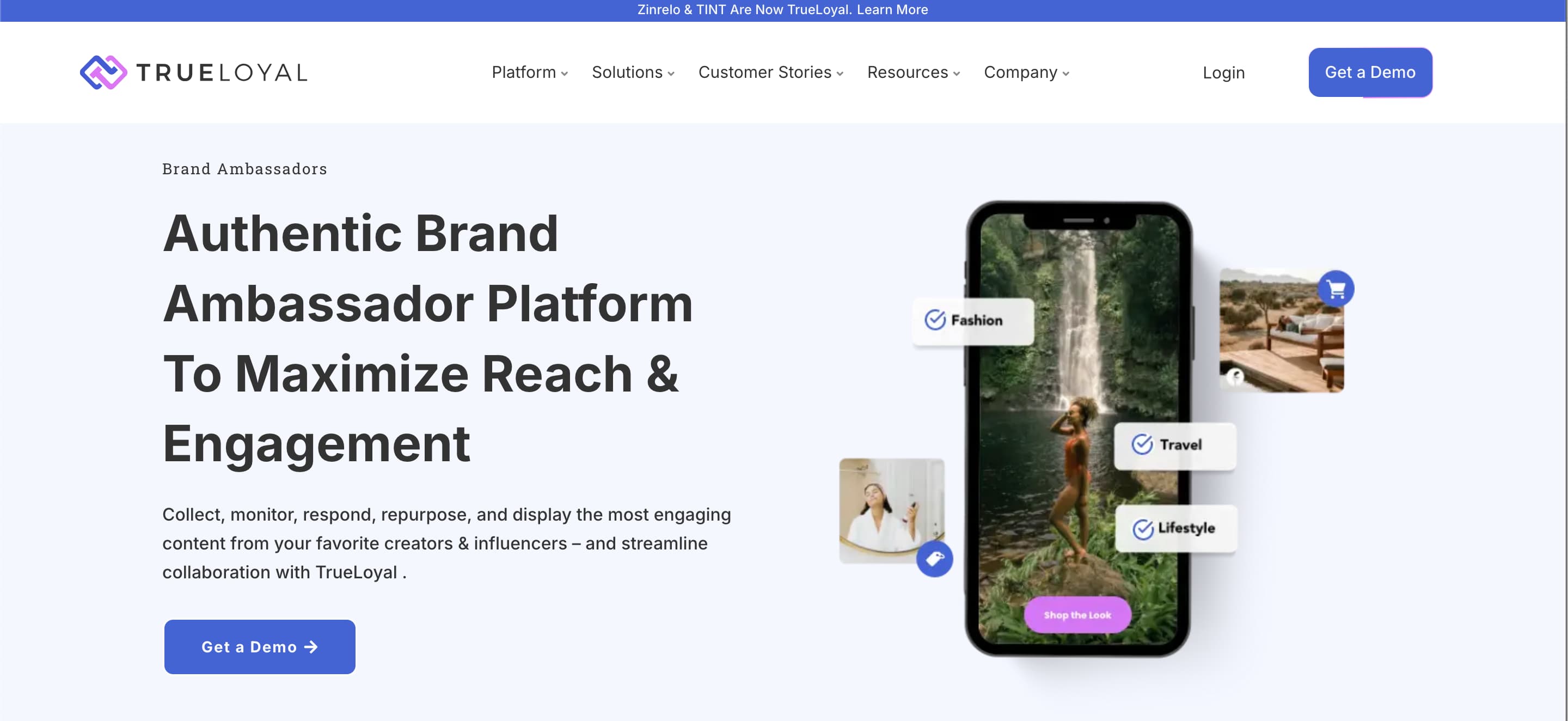
Best For: TrueLoyal is best for brands looking to centralize their influencer collaboration processes. It’s designed for businesses aiming to manage brand ambassador programs, streamline creator engagement, and optimize influencer content for product page conversions, particularly in e-commerce settings.
Platform Coverage:
Pricing: Undisclosed.
Reviews: 4.3 / 5.0 (G2)
Ease of Use (UX/UI): TrueLoyal is known for its intuitive interface, allowing brands to seamlessly manage influencer collaborations. Users appreciate its ability to consolidate creator, influencer, and customer content in one location. While the platform integrates well with existing e-commerce tools, some users have noted that the interface might feel overwhelming initially due to its wide range of features.
Customer Support: Users commend TrueLoyal’s customer support, which includes personalized assistance from a dedicated account manager via WhatsApp and email. Support is generally responsive, offering prompt solutions to issues, particularly regarding content management and collaboration workflows. However, some users have mentioned that the platform’s self-service options could be more robust.
Famstar offers influencer discovery and campaign management features, but TrueLoyal places a strong emphasis on centralizing creator content and social proof for e-commerce brands, integrating easily into product pages.
TrueLoyal’s pricing is typically managed with a $1,000/month service, delivering 30-40 influencers/month, which is ideal for brands needing scalable influencer discovery. In contrast, Famstar’s pricing is more tailored to small-to-mid-sized businesses with affordable packages suited for brands that prioritize automated outreach and affiliate management.
Overall, TrueLoyal is recommended for brands heavily invested in product page integration and UGC management, while Famstar may be better suited for those seeking more automation and a broader range of features beyond influencer management.
When evaluating alternatives to Famstar, it's clear that platforms like Influencer Hero offer powerful tools to streamline influencer marketing campaigns with a focus on easy-to-use workflows, comprehensive analytics, and automated outreach. While Famstar provides flexibility with various features, Influencer Hero stands out for its all-in-one influencer marketing CRM, which integrates seamlessly with e-commerce platforms and offers robust tools for campaign management, influencer discovery, and performance tracking. If you're looking for a platform that offers a more personalized experience with a focus on automating processes and optimizing campaign performance, Influencer Hero is a strong choice.
For brands looking to scale their influencer programs with an intuitive, user-friendly interface, Influencer Hero is a top contender in the market. With advanced reporting, customizable outreach tools, and seamless integrations with major platforms, Influencer Hero provides a complete solution for influencer collaboration and management.
Ready to take your influencer marketing to the next level? Book a demo with Influencer Hero today to explore how our platform can optimize your campaigns.

Some of the top Famstar alternatives for influencer marketing in 2025 include Influencer Hero, Modash, Upfluence and TrueLoyal. These platforms offer similar tools for discovering influencers, managing campaigns, and tracking performance, but each stands out with unique features. Influencer Hero, for instance, focuses on an all-in-one influencer marketing solution for brands, helping with creator discovery, outreach, and campaign optimization. Check the comparison in this article to find the best fit for your business needs.
Influencer Hero provides a comprehensive influencer marketing platform with tools for creator outreach, campaign management, and performance tracking—much like Famstar. However, Influencer Hero stands out with its global reach, analytics, and user-friendly interface. It’s particularly useful for brands that want to scale their campaigns, leveraging influencers from different platforms. Unlike Famstar, which is focused more on the Indian market, Influencer Hero offers broader international support.
Yes! Influencer Hero offers features that Famstar doesn’t, such as advanced segmentation for micro and nano influencers, and an integrated dashboard to track sales and commissions in real time. Influencer Hero also allows for automated outreach and integrated CRM tools, helping brands streamline their entire influencer marketing process. If you're looking for more flexibility and cross-border influencer support, Influencer Hero could be the better option compared to Famstar’s focus on India.
The pricing models for Famstar alternatives vary based on features and scale:
When choosing between Famstar and alternatives like Influencer Hero, Nindo, and Partnerize, consider these factors:



Schedule a Demo with one of our media experts below.